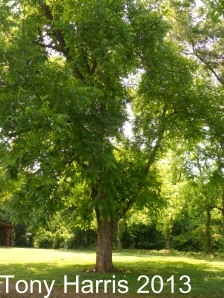Black Walnut Juglans niger Cherokee Se-di 
The Cherokee used the Black Walnut several ways for medicinal purposes. An infusion of the inner bark was taken for smallpox. This was important because there were two outbreaks of smallpox, brought by European immigrants prior to the Trail of Tears, that killed half of the Cherokee population alive each time. Some Elders have said that the bark was chewed for toothaches. A poultice was made from the husks to aid in the drop off of the umbilical cord from newborn babies. It was taboo for a pregnant women to eat Black Walnuts because it was believed to cause the baby to develop a broad nose. The sap from the inner bark was used as an antiseptic for varies skin conditions.
The nuts were mixed with hominy corn and pinto beans to make a porridge. A brown dye was made from the husks for use in dyeing baskets and clothing. The husks were crushed and mixed with water to ferment and then poured into a stream, river or lake to stun fish so they could be netted or gigged. They also used the hardwood to make tools and weapons. Today the wood is used as flooring, furniture and airplane propellers.
Never plant a garden close to a Black Walnut tree because the tree gives off a substance called Juglone, which is toxic to some plants and or trees. This substance is a respiratory inhibitor to some plants. As a rule of thumb all vegetables and all species of hydrangeas, blueberries, columbine, apples, mountain laurel, rhodedendrons and azaleas are considered sensitive.
Someone asked me if you could compost Black Walnut leaves. The answer is yes, if you compost them by themselves for a couple of months. Most of the Juglone is concentrated in the root system vs. the leaves. The test to see if your compost is ready to be used around sensitive plants is to plant a small tomato seedling in the compost, and it it continue to grow vs. wilt, then the compost can safely be used around your other plants.
My parents had a Black Walnut tree on our property, and I learned early on that you strip the green husk from the nut after they drop because the nut will taste better later. I also learned that the best way to crack a Black Walnut was with my father’s vise in the barn.
